◄ Carnets Geol. 16 (8) ►
Contents
[Introduction]
[1. Historical review]
[2. New finds]
[Conclusions]
[Bibliographic references] and ... [Plates]
Dépt. STU, Fac. Sci. Tech., UBO, CS 93837, F-29238 Brest (France)
Department of Ecology and Evolutionary Biology, The University of Kansas, 1200 Sunnyside
Avenue, Lawrence, Kansas 66045 (USA)
Oolithica
Geoscience Ltd, 53-57 Rodney Road, Cheltenham GL50 1HX, Gloucestershire (United
Kingdom)
Lebanese University, Faculty of Science II, Fanar, Natural Sciences Department, Fanar - El-Matn, P.O. Box 26110217 (Lebanon)
Lebanese
University, Faculty of Science II, Fanar, Natural Sciences Department, Fanar -
El-Matn, P.O. Box 26110217 (Lebanon)
Lebanese University, Faculty of Science II, Fanar, Natural Sciences Department, Fanar - El-Matn, P.O. Box 26110217 (Lebanon)
Published online in final form (pdf) on April 14, 2016
[Editor:
Michel ; technical editor: Bruno ;
language editor: Phil ]
The stratigraphic framework of the Upper Jurassic and Lower Cretaceous strata of Lebanon that dates back to 's publications required either consolidation or full revision. The preliminary results of our investigations in the Mount Lebanon region are presented here. We provide new micropaleontological and sedimentological information on the Salima Oolitic Limestones, which is probably an unconformity-bounded unit (possibly Early Valanginian in age), and the "Grès du Liban" (Barremian in age). Our revised bio- and holostratigraphic interpretations and the new age assignations lead us to emphasize the importance of the two hiatuses in the sedimentary record below and above the Salima, i.e., at the transition from the Jurassic to the Cretaceous.
Tithonian; Valanginian; Barremian; hiatus; unconformity; Salima Oolitic Limestones; "Grès du Liban"; amber; Balkhania.
B., C., R., D. & S. (2016).- Some steps toward a new story for the Jurassic - Cretaceous transition in Mount Lebanon.- Carnets Geol., Madrid, vol. 16, no. 8, p. 247-269.
Avancées dans une réécriture de l'histoire de la transition du Jurassique au Crétacé dans le Mont Liban.- Le canevas stratigraphique du Jurassique supérieur et du Crétacé inférieur du Liban date des publications anciennes de et aurait donc besoin d'être soit toiletté et consolidé, soit révisé de fond en comble. Les résultats préliminaires de nos recherches dans la région du Mont Liban sont exposés ici. Nous fournissons des données micropaléontologiques et sédimentologiques inédites sur les Calcaires oolithiques de Salima, qui constituent vraisemblablement une unité lithostratigraphique particulière, une "UBU", car encadrée par deux discontinuités (probablement d'âge Valanginien inférieur), et sur le Grès du Liban (d'âge barrémien). Nos nouvelles interprétations bio- et holostratigraphiques, ainsi que nos nouvelles attributions chronostratigraphiques, nous permettent de souligner l'importance des deux lacunes sédimentaires encadrant les Calcaires oolithiques de Salima, c'est-à-dire des lacunes significatives situées dans l'intervalle de transition du Jurassique au Crétacé.
Tithonien ; Valanginien ; Barrémien ; hiatus ; discordance ; Calcaires oolithiques de Salima ; Grès du Liban ; ambre ; Balkhania.
In
Lebanon, uppermost Jurassic strata are carbonate rocks forming cliffs that
contrast with the gentle landforms, commonly covered by stone pine (Pinus
pinea) forests, of the overlying lowermost Cretaceous strata consisting of
shales, unconsolidated sands, and sandstones. From our reading of
(1963), the Jurassic - Cretaceous boundary corresponds to a discontinuity
associated with a significant time hiatus (i.e., a hiatus equivalent to
the duration of one or two stages, the Tithonian or the Tithonian and the
Berriasian). We present new data regarding the transition strata between the
Jurassic and the Cretaceous from Bikfaya (, 2000: 33°55'20"N,
35°42'40"E; 33°55'20.4"N, 35°42'29.1"E), also spelled
"Bikfayia", Douar (33°53'60.0"N, 35°41'42.2"E), Ain Al
Soufsaf Mrouj (location not precisely known) and Jeita (33°57'18.34"N, 35°37'47.86"E),
all three in the Matn District, and Bkâatouta (33°58'08.0"N, 35°47'04.1"E)
in the Keserwan District (Fig. 1 ![]() ).
).
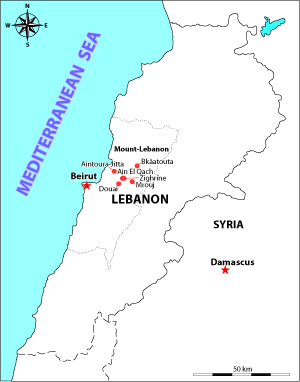
Click on thumbnail to enlarge the image.
Figure 1: Location map of the studied outcrops. Matn District: Ain El Qach, near Bikfaya (33°55'20.4"N, 35°42'29.1"E), Aintoura Jitta, near Jeita (33°57'18.34"N, 35°37'47.86"E); Douar (33°53'60.0"N, 35°41'42.2"E); Ain Al Soufsaf, near Mrouj (33°54'13.99"N, 35°44'05.74"E); Zighrine, near Bikfaya (33°55'20"N, 35°42'40"E); Keserwan District: Bkâatouta section (33°58'08.0"N, 35°47'04.1"E).
Half a century ago, the knowledge of the Upper Jurassic and Lower Cretaceous stratigraphy of Lebanon was summarized in 's views (1963, respectively in p. 62-77 under "Jurassique de …" and p. 92-93 under "Néocomien") as part of his issue of the Lexique Stratigraphique International dedicated to Lebanon. It is not obvious what the concept of "Néocomien" was for in 1963 because there is no reference to the Barremian stage between his "Néocomien" and his "Aptien inférieur". We assumed that he included the Barremian into the Neocomian. Similarly, with respect to the Tithonian and Berriasian stages, we assumed that he considered that they are missing in Lebanon. In any case, today his work can be regarded as outdated: 's approach (1904-1979) was mostly facies-driven and, on rare occasions only, his lithostratigraphic units were bounded by unconformities. In addition, the biostratigraphic information he was refering to was mostly based on macrofossils (rare ammonites, few echinids, pelecypods and brachiopods).
In
contrast, before and mostly after WWII, oil exploration and production in the
Middle East region led to the development of micropaleontology as a powerful
alternative to resolve biostratigraphic issues that macropaleontology could not.
Accordingly, it is worth mentioning the work of some lead micropaleontologists,
among whom F.R.S. (1948a,
1948b), W. (1959), C.D.
(1964; & ,
1991), N.J. (,
2012), and A.H. , for the foraminifers, as well as G.F.
(1968) and H.S. (in & ,
1971), for
the calcareous algae. Amazingly, there is not a single reference to 's
work in 's publications suggesting that he was rather
sceptical regarding such micropaleontological approaches (except for quoting
occurences of Orbitolina conoidea and O. discoidea … two
"species" that nobody would refer to today!). Obviously,
and (1937) could not have been unaware of them. For example, one
of us (BG) found in 's
collection a set of thin sections dating back to the 1930's with some
classical Middle and Late Jurassic foraminifers (see Pl. 1 ![]() , figs. 1-10 &
12-18). The death of in 1979 (,
1985) could have
marked the beginning of a new era for Lebanese geology but the Lebanese Civil
War had already started and lasted
for some more years. First photomicrographs of Lebanese Jurassic microfossils
correspond to calcareous algae documented by &
(1971), followed by foraminifers documented by
(1980) for the
Anti-Lebanon Range.
, figs. 1-10 &
12-18). The death of in 1979 (,
1985) could have
marked the beginning of a new era for Lebanese geology but the Lebanese Civil
War had already started and lasted
for some more years. First photomicrographs of Lebanese Jurassic microfossils
correspond to calcareous algae documented by &
(1971), followed by foraminifers documented by
(1980) for the
Anti-Lebanon Range.
Indeed, was also very critical regarding the use of macrofossils. For instance, when (1926) was ascribing to the "Tithonique" stage (nota bene: probably including the Berriasian as a substage) the uppermost Salima oolitic limestones ("Calcaires de Salima") - j7 or when (1942) was ascribring to the "Portlandien" the set consisting from bottom to top of the Bhannes volcano-sedimentary unit ("niveau basaltique de Bhannès") - ßj6, the Bikfaya limestones ("falaise de Bikfaya") - j6a and the Salima limestones - j7, (1963, p. 114) stated that, nevertheless, the faunas are not diagnostic enough to allow identification of a stage ("les faunes ne sont cependant pas assez caractéristiques pour permettre de définir un étage"). Similarly when (1951) identified supposedly Kimmeridgian and Tithonian faunas in ßj6 and Late Tithonian faunas in both j6a and j7, (1963, p. 76) concluded that the faunas listed did not ensure the accuracy of the stratigraphical information provided ("les faunes citées ne permettent pas les précisions stratigraphiques données").
One not
only needs list of species but also requires the finds to be documented by
photographs. One of us (, 2000) provided the first
micropaleontological evidence ("Chitinoidella insueta ,
1986") for the presence of Lower-Middle Tithonian strata: at that time no
photomicrographs accompanied his text. Fortunately,
today we shall fill this gap (Fig. 2.A ![]() ). Besides that, a photo can point out
dubious or erroneous identifications. For example, we document hereafter two
cases involving Anchispirocyclina lusitanica (, 1902) [see ,
1959], a marker for the Tithonian - Lower Berriasian interval (
& , 2011):
). Besides that, a photo can point out
dubious or erroneous identifications. For example, we document hereafter two
cases involving Anchispirocyclina lusitanica (, 1902) [see ,
1959], a marker for the Tithonian - Lower Berriasian interval (
& , 2011):
without citing their source, and (2002, Fig. 5) illustrate under "Anchispirocyclina" [and "Larger benethic (sic) foraminifera of late Jurassic - Early cretaceous (sic) age" as supplementary information] the paratype of Bramkampella arabica (, 1964, Pl. 1, fig. 26; also re-illustrated by & , 1991, Pl. 2, fig. 7);
the same year, and (2002, Pl. 1, figs. 3-8) ascribe to Anchispirocyclina lusitanica random (oblique) sections of Alveosepta sp. from the Bhannès ignous-sedimentary unit, which probably falls within the Kimmeridgian interval (, 1980; & , 2004), not in the Tithonian - Lower Berriasian interval.
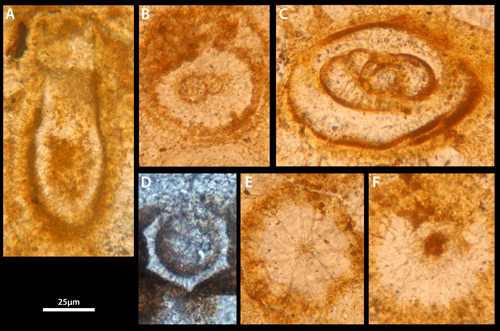
Click on thumbnail to enlarge the image.
Figure 2:
A-F)
thin sections from the Collection, unnamed unit, lower part of the
former "Calcaire de Salima", Bikfaya, Matn District: A-C & E-F) thin
section 78m; E) thin section 62m. [All photos with the same graphical scale =
25µm]
A) Cylindrella
insueta (, 1986); B) incertae sedis with a
hyaline fibro-radiate outer layer; C) miliolid; D) cf. Stomiosphaera echinata
, 1968, or a ? Nodosariid; E) cf. Gemeridella minuta & ,
1975; F) incertae sedis.
Regarding
the "Grès du Liban" – c1, and
(1937)
refer to its upper part, which begins with the first fossiliferous strata
("depuis les premières couches fossilifères"), as the Lower Aptian
substage (= Bedoulian stage) and its unfossiliferous lower part as the Neocomian
stage. According to (1976, p. 86),
(1963a, 1963b, 1964) "ascribed" the lower unfossiliferous part "mostly to the
Neocomian" with an "upper limit" (…) "extended" (…) "to the
Hauterivian - Barremian". Amazingly, regarding the age of the "Grès du
Liban", (1980, p. 241) stated against all odds that the age
of this unit is conventionally given as ? Barremian-Aptian ("l'âge
de cette formation est classiquement déterminé comme ? Barrémien
– Aptien"). We presume that this last author, a micropaleontologist, had the
same reasoning as and
(1995) regarding the
equivalent unit in the Syrian Coastal Mountain Range and ascribing it an Early
Aptian (= Bedoulian) age. According
to and (1995), this unit yields from its bottom
both the Foraminifer Choffatella decipiens and the
Dasycladale Salpingoporella (Hensonella) dinarica that
clearly point to an Early Aptian age ("renferme dès sa base le Foraminifère Choffatella
decipiens et la Dasycladale Salpingoporella
(Hensonella) dinarica
, qui indiquent clairement l'Aptien inférieur").
We do not question the identifications because both species can always be easily
identified. However, we do question the age assignment. As a matter of facts, if
Choffatella gr. decipiens (see Pl. 2 ![]() , figs. 1-3) does range up to
the Upper Aptian ( & ,
2013), "It probably
starts in the Valanginian because it may derive from Choffatella pyrenaica
, 1976" ( et al.,
2014). In addition,
the total range of Salpingoporella (Hensonella) dinarica is (? Tithonian -) Berriasian
to Albian (, 2002). In conclusion, except for the upper boundary
of the "Grès du Liban", which is Late Barremian in age (
et al., 2014, 2016;
, 2015;
et al., 2015), the age of the lower boundary and the duration of the unit
remain unknown.
, figs. 1-3) does range up to
the Upper Aptian ( & ,
2013), "It probably
starts in the Valanginian because it may derive from Choffatella pyrenaica
, 1976" ( et al.,
2014). In addition,
the total range of Salpingoporella (Hensonella) dinarica is (? Tithonian -) Berriasian
to Albian (, 2002). In conclusion, except for the upper boundary
of the "Grès du Liban", which is Late Barremian in age (
et al., 2014, 2016;
, 2015;
et al., 2015), the age of the lower boundary and the duration of the unit
remain unknown.
The Bikfayia section, almost 150m thick, was originally measured by one of us (, 2000) near Zighrine (33°55'20"N, 35°42'40"E). Sample /thin section/ numbering is given in meters. It consists from base to top of:
0-58.5m:
limestones with various fabrics under binocular microscope (bioclastic mud-
and wackestones, pelletoidal ? packstones, pieces of corals and
stromatoporoids). Sponge spicules are commonly found there; Permocalculus
algal remains are also common from 30m upward, forming most of the rock from
47.5m to the top. The occurrence of Campbeliella striata (,
1954) in samples at 2m and 4m (Pl. 3 ![]() , figs. 1-2) points to a Late
Kimmeridgian – Tithonian age; this alga is associated to Rajkaella
bartheli (, 1971) (Pl. 3
, figs. 1-2) points to a Late
Kimmeridgian – Tithonian age; this alga is associated to Rajkaella
bartheli (, 1971) (Pl. 3 ![]() , figs. 3-4), which is known from
the Upper Kimmeridgian to the Berriasian. Apart from Campbeliella,
there are no age diagnostic microfossils in this first interval refered to
as "Falaise de Bikfaya";
, figs. 3-4), which is known from
the Upper Kimmeridgian to the Berriasian. Apart from Campbeliella,
there are no age diagnostic microfossils in this first interval refered to
as "Falaise de Bikfaya";
58.5-61.1m: this shaly interval corresponds to a flooding period (, 2000);
61.1-85m:
limestones with various fabrics: Permocalculus wackestone,
pelletoidal ? packstones, bioclastic /large agglutinating foraminifers,
aggregates/ floatstones with pelletoidal grainstone matrices, etc. In
a sample from 78m, (2000) identified Cylindrella insueta
(, 1986) (Fig. 2.A ![]() ), a marker for the Lower-Middle
Tithonian. Various incertae sedis (Fig. 2.B &
D-F
), a marker for the Lower-Middle
Tithonian. Various incertae sedis (Fig. 2.B &
D-F ![]() ), including
the long-ranging forms, cf. Gemeridella minuta & ,
1975 (Fig. 2.E
), including
the long-ranging forms, cf. Gemeridella minuta & ,
1975 (Fig. 2.E ![]() ), and cf. Stomiosphaera echinata , 1968
(Fig. 2.D
), and cf. Stomiosphaera echinata , 1968
(Fig. 2.D ![]() ), are also reported from this interval;
), are also reported from this interval;
85-100m: a hiatus, i.e., an interval "poorly exposed at this locality, being covered by scree and scrub vegetation" (, 2000);
100-123.85m:
oolitic limestones. The ooid cortices are of the radial to concentric type (,
1986; , 1994,
1995, 2014); the nuclei are commonly micritized
grains and bioclasts; there are few hemiooids. The formerly aragonitic
foraminifers, Frentzenella odukpaniensis
(, 1968) (Pl. 3 ![]() , figs. 5-8, 11-12 & 14-15) and Coscinoconus sp.
(Pl. 3
, figs. 5-8, 11-12 & 14-15) and Coscinoconus sp.
(Pl. 3 ![]() ,
figs. 9-10 & ? 16), originally identified as "Trocholina"
(see et al., 2013),
are rather common there. The interval 58.5-123.85m was previously referred to as "Calcaire de Salima"
(, 2000); today we restrict the use of Salima Limestones to the
sole uppermost oolitic interval, i.e., from 100 up to 123.85m. The
same interval was resampled recently in a neighbouring quarry near Ain El
Qach (33°55'20.4"N, 35°42'29.1"E: Fig. 3
,
figs. 9-10 & ? 16), originally identified as "Trocholina"
(see et al., 2013),
are rather common there. The interval 58.5-123.85m was previously referred to as "Calcaire de Salima"
(, 2000); today we restrict the use of Salima Limestones to the
sole uppermost oolitic interval, i.e., from 100 up to 123.85m. The
same interval was resampled recently in a neighbouring quarry near Ain El
Qach (33°55'20.4"N, 35°42'29.1"E: Fig. 3 ![]() ). One sample bears
numerous Neotrocholina valdensis ,
1957 (Pl. 4
). One sample bears
numerous Neotrocholina valdensis ,
1957 (Pl. 4 ![]() , figs.
13-21 & 41-45), and Protopeneroplis ultragranulata (,
1971) (Pl. 4
, figs.
13-21 & 41-45), and Protopeneroplis ultragranulata (,
1971) (Pl. 4 ![]() , figs.
5-7), a foraminifer ranging in age from the Late Tithonian to the Barremian
(, 1993; & ,
2011);
, figs.
5-7), a foraminifer ranging in age from the Late Tithonian to the Barremian
(, 1993; & ,
2011);
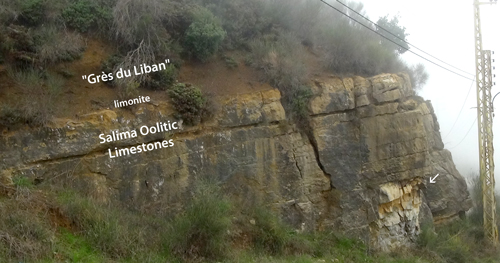
Click on thumbnail to enlarge the image.
Figure 3: Contact of the "Grès du Liban", here limonite and shales (above), and the Salima Oolitic Limestones (below). New sampling location arrowed. Ain El Qach (33°55'20.4"N, 35°42'29.1"E), Matn District.
123.85-126.5m:
ferruginous oolite (Pl. 3 ![]() , fig. 18) with some quartz silt. Quartz is the
"fossil" marker for the "Grès du Liban". Calcareous grains, e.g.,
echinoderm remains (Pl. 3
, fig. 18) with some quartz silt. Quartz is the
"fossil" marker for the "Grès du Liban". Calcareous grains, e.g.,
echinoderm remains (Pl. 3 ![]() , fig. 17), possibly reworked from the underlying
unit, are commonly dissolved;
, fig. 17), possibly reworked from the underlying
unit, are commonly dissolved;
126.5-140m:
a hiatus corresponding to a "recessive weathering profile" (,
2000) probably dominantly shaly. In other places, it may be a sandstone (Fig. 4 ![]() );
);
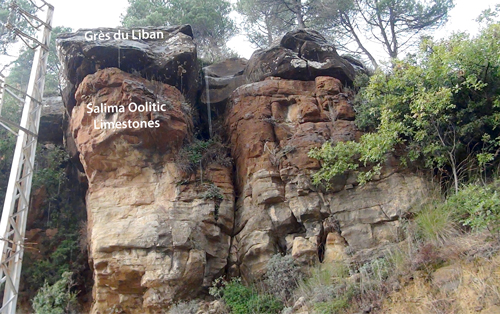
Click on thumbnail to enlarge the image.
Figure 4: Contact of the "Grès du Liban", here sandstones (above), and the Salima Oolitic Limestones (below). Ain Al Soufsaf (33°54'13.99"N, 35°44'05.74"E), near Mrouj, Matn District.
140-151.1m
(end of the section): oolitic limestones with some quartz sand. The ooid
cortices are of the concentric to micritic type (,
1986; , 1994,
1995, 2014); the nuclei are bioclasts,
extraclasts (Pl. 3 ![]() ,
fig. 20), calcareous micritized, ? rhyolitic-quartz and
ferruginous grains. There is no age diagnostic microfossil in this interval.
It is worth mentioning that a sample at 140m is brecciated with open
fractures filled in by micrite (Pl. 3
,
fig. 20), calcareous micritized, ? rhyolitic-quartz and
ferruginous grains. There is no age diagnostic microfossil in this interval.
It is worth mentioning that a sample at 140m is brecciated with open
fractures filled in by micrite (Pl. 3 ![]() , fig. 19).
The fracturing took place after drusy phreatic cementation and long after
early fibrous marine cementation.
, fig. 19).
The fracturing took place after drusy phreatic cementation and long after
early fibrous marine cementation.
The
upper boundary of the Salima Oolitic Limestones, i.e., the lower boundary
of the "Grès du Liban", is a sharp surface with locally well preserved
karstic features (possible former fractures enlarged by adjacent meteoric
dissolution on their walls in the country limestone) as, for instance, 2.5 km
southwestward (33°53'60.0"N, 35°41'42.2"E) near Douar (Fig.
5 ![]() ). An
issue still to be clarified concerns the lower boundary of the Salima Oolitic
Limestones and a side issue concerns the age of this unconformity-bounded unit.
We assume that this lower boundary probably marks a significant downward shift of
facies, i.e., a huge relative sea-level fall followed by a transgression.
The best candidate sequence on the chart of P. and co-workers is the
Early Valanginian one, because it is sandwiched between two huge forced
regressions and associated with the earliest
major Cretaceous transgression. On
the opposite side of the Arabian plate, in the United Arab Emirates, it
corresponds to the Zakum(-ian) regional stage ( et al.,
2011).
). An
issue still to be clarified concerns the lower boundary of the Salima Oolitic
Limestones and a side issue concerns the age of this unconformity-bounded unit.
We assume that this lower boundary probably marks a significant downward shift of
facies, i.e., a huge relative sea-level fall followed by a transgression.
The best candidate sequence on the chart of P. and co-workers is the
Early Valanginian one, because it is sandwiched between two huge forced
regressions and associated with the earliest
major Cretaceous transgression. On
the opposite side of the Arabian plate, in the United Arab Emirates, it
corresponds to the Zakum(-ian) regional stage ( et al.,
2011).

Click on thumbnail to enlarge the image.
Figure 5: Karstic features (possible former fractures enlarged by adjacent meteoric dissolution on their walls in the country limestone). A) Sedimentary infilling with cobbles and pebbles. B-C) Veneers on a fracture or karstic walls (large quartz grains arrowed). Douar (33°53'60.0"N, 35°41'42.2"E), Matn District. [hammer for scale]
There
are few limestone intercalations in the "Grès du Liban"; marine limestones
in its fossiliferous upper part (e.g., "Banc de Mréjatt" of ,
1942), palustrine or lacustrine limestones in its lower part (e.g.,
"Calcaire à pisolithes" of , 1942; et
al., 2015). In the Bkâatouta section (33°58'08.0"N, 35°47'04.1"E),
the "Grès du Liban" (the whole interval comprised between the Salima
Oolitic Limestones below and the Jezzinian limestones above) exceeds 300m in
total thickness. Approximately ten
meters above its lower boundary, in a similar setting as that of the Bikfayia
section, one of us (R.G.) found several metric beds made of marine limestones (Fig.
6 ![]() ). This time, however, the limestones do not consist of ooid grainstones
but of bioclastic mud- and wackestones. Note that such occurrences of marine
limestones in both localities may look like anomalies because the lower part of
the "Grès du Liban" was supposedly unfossiliferous and nonmarine. Here the
larger grains are foraminifers, commonly forming the coated nuclei of oncoids.
The microfossil assemblage consists of Frentzenella
odukpaniensis (, 1968)
and various Coscinoconus sp., among which is a low-spired morphospecies (Pl.
5
). This time, however, the limestones do not consist of ooid grainstones
but of bioclastic mud- and wackestones. Note that such occurrences of marine
limestones in both localities may look like anomalies because the lower part of
the "Grès du Liban" was supposedly unfossiliferous and nonmarine. Here the
larger grains are foraminifers, commonly forming the coated nuclei of oncoids.
The microfossil assemblage consists of Frentzenella
odukpaniensis (, 1968)
and various Coscinoconus sp., among which is a low-spired morphospecies (Pl.
5 ![]() , figs. 1-4 & 9-10) similar to those found in the Salima
Oolitic Limestones and a high-spired
one (Pl.
5
, figs. 1-4 & 9-10) similar to those found in the Salima
Oolitic Limestones and a high-spired
one (Pl.
5 ![]() , figs.
14-18 & 20). In addition, we identified a large benthic foraminifer, Balkhania
balkhanica , 1966 (Fig.
7
, figs.
14-18 & 20). In addition, we identified a large benthic foraminifer, Balkhania
balkhanica , 1966 (Fig.
7 ![]() ;
Pl.
5
;
Pl.
5 ![]() , fig. 21;
Pl. 6
, fig. 21;
Pl. 6 ![]() , figs. 1-7).
, figs. 1-7).
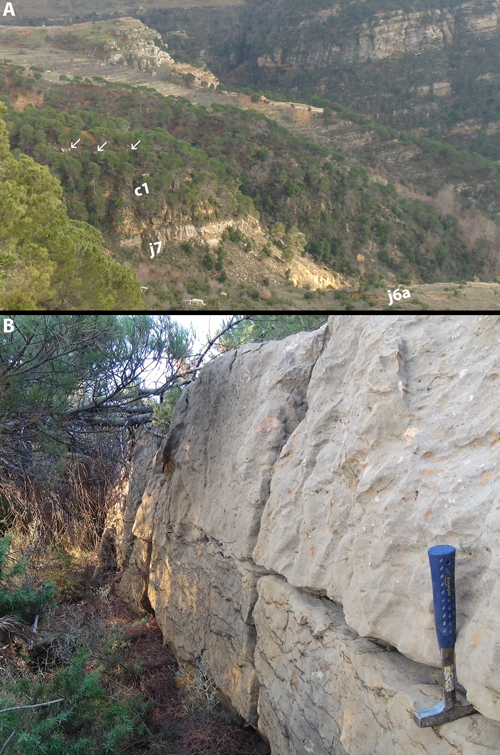
Click on thumbnail to enlarge the image.
Figure 6: A) Bkâatouta section (33°58'08.0"N, 35°47'04.1"E), Keserwan District. Limestones at the bottom of the "Grès du Liban" are arrowed. j6a: "falaise de Bikfaya", j7: "Calcaires de Salima", c1: "Grès du Liban"; B) Detail view of the limestones at at the bottom of the "Grès du Liban", which are gently dipping eastward (N160°E, 15°E). [hammer for scale]
The find of Balkhania balkhanica , 1966, opens new avenues for the understanding of the regional stratigraphy and paleobiogeography:
as pointed out by M. (personal communication to B.G., 22/01/2016), Balkhania balkhanica , 1966, is an almost perfect homeomorph of Alzonella & , 1970, and Pseudochoffatella , 1976 (non 1961). These monospecific taxa are respectively Bathonian and Late Aptian-Early Albian in age whereas Balkhania is Barremian-Early Aptian (= Bedoulian) in age;
so far, it was only known from Afghanistan, Iran and Turkmenistan, on the northern margin of the Neotethys ( et al., 2013). The Lebanese find is the first record on the southern margin of the Tethys;
this species enables us to ascribe a Barremian age to the whole "Grès du Liban" in the studied area.

Click on thumbnail to enlarge the image.
Figure 7: Balkhania balkhanica , 1966, probably a microspheric form. Thin section BR1519, "Grès du Liban" (Barremian), Bkâatouta, Keserwan District. [scale bar 500 µm]
In the Matn District, the Bikfaya Limestones fall into the Upper Kimmeridgian - Tithonian interval. In the unnamed unit above them, (2000) identified Cylindrella insueta (, 1986), the first and only evidence for an Early-Middle Tithonian age. The next unit, i.e., the Salima Oolitic Limestones, is most likely Early Valanginian in age, a "working" hypothesis in need of consolidation:
A) if it proves to be correct, i.e., if the Salima Oolitic Limestones are Early Valanginian in age, the Jurassic-Cretaceous boundary would be at the Salima lower unconformity with a time gap equivalent at least to the duration of the Berriasian stage;
B) if we are wrong, the Salima Oolitic Limestones will fall into the Upper Tithonian - Berriasian interval, excluding the Valanginian. At this point there are two secondary options to consider: 1) the Salima Oolitic Limestones are Late Tithonian in age and the Jurassic-Cretaceous boundary is then located at the Salima upper unconformity; 2) these limestones are Berriasian in age and the boundary is then located at the Salima lower unconformity. In any case, the time gap associated to the Salima lower unconformity would be shorter than the duration of a stage.
Regarding the last unit, i.e., the "Grès du Liban", there are no age-diagnostic microfossil in the oolitic grainstones found at the bottom of this unit in the Bikfayia section (Matn District).
In
contrast, in the Keserwan District, the bioclastic wackestones found at the
bottom of the "Grès du Liban" in the Bkâatouta section yield the
foraminifer Balkhania balkhanica , 1966, a marker for the
Barremian-Lower Aptian (= Bedoulian) interval. Consequently, because the
overlying unit, i.e., the Jezzinian, is latest Barremian and earliest
Aptian (= early Bedoulian) in age the whole "Grès du Liban" can be
correlated with the Barremian stage! Considering the previous "working"
hypothesis with respect to the Salima upper unconformity, there are several
options (Fig. 8 ![]() ):
):
A) the hiatus would be equivalent at least to the duration of the Late Valanginian substage and the Hauterivian stage (our favorite option);
B-1) it would be equivalent at least to the duration of the Berriasian, Valanginian and Hauterivian stages;
B-2) it would be equivalent at least to the duration of the Valanginian and Hauterivian stages.
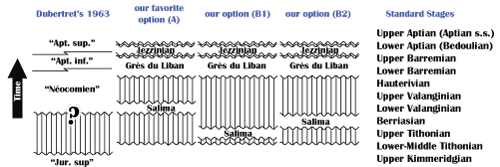
Click on thumbnail to enlarge the image.
Figure 8: The several interpretations of the hiatuses at the Jurassic-Cretaceous transition. Our interpretation of 's view is given in the first column (see comments in the chapter "Historical review"). Our favorite option, is by far option A, in the second column; however, options B1 and B2, in the third and fourth columns respectively, should not be totally excluded. Caption: "Jur. sup." = "Jurassique supérieur" ; "Apt. inf." = "Aptien inférieur" ; "Apt. sup." = "Aptien supérieur".
To summarize, we can state that both discontinuities, lower and upper, that bind the Salima Oolitic Limestones, correspond to two significant hiatuses, which contrasts with the earlier hypothesis of a single discontinuity with a hiatus spanning at least the Tithonian and possibly the Berriasian.
The lower part of the "Grès du Liban" was supposely nonmarine and unfossiliferous but it is comprised of marine and fossiliferous strata near its base. The new dating of the "Grès du Liban" in Mount Lebanon, i.e., a Barremian age, leads us to better constrain the age of the so-called "Early Cretaceous extension" and of the related magmatic events in the Levant area. As a side result of our study, the age of the amber with biological inclusions found in the "Grès du Liban" is restricted to the Early Barremian, with reworking in Late Barremian times, not Early Barremian and possibly older as up until very recently envisaged ( et al., 2016).
A part of the studied material, consisting of thin sections, is deposited with LPB ("Laboratoire de Paléontologie de Brest") numbers in the collections of the "Département des Sciences de la Terre et de l'Univers, Université de Bretagne Occidentale", Brest (France); another part belongs to the Collection of Oolithica Geoscience Ltd., Cheltenham (United Kingdom).
We would like to thank the CNRSL (National Council for Scientific Research-Lebanon) for its financial support. This research is a side and late contribution to the project no. 30959NJ - PHC CEDRE 2014, supported by of the research project of Hubert Partnership program (PHC) CEDRE; implemented in Lebanon and France by the Ministry of Foreign Affairs (Ministère des Affaires étrangères, MAE) and the Ministry of Higher Education and Research (Ministère de l'Enseignement Supérieur et de la Recherche, MESR) led by Bruno (France) and Dany (Lebanon). The Foundation "Carnets de Géologie" has provided financial support to the first author (B.G.) for his missions to Beirut and Lebanon. This paper is also a contribution of the team project "Biodiversity: Origin, Structure, Evolution and Geology" led by Dany at the Lebanese University.
Ioan I. and Michel are thanked for their detailed critical reviews of the original manuscript; Phil helped polishing the English text.
F.T. & J.E (1991).- 's "new lituolid foraminifera" from the Mesozoic of Saudi Arabia.- Micropaleontology, New York, vol. 37, no. 1, p. 41-59 (6 Pls.).
P.W. & H.S. (1971).- Calcareous algae from the Jurassic and Cretaceous of Lebanon.- Micropaleontology, vol. 17, no. 4, p. 411-433.
P. & M. (1970).- Alzonella cuvillieri n.gen., n.sp., nouveau genre de foraminifère du Bathonien de la bordure méridionale des Cévennes.- Revue de Micropaléontologie, Paris, vol. 13, no. 1, p. 3-12.
G. (1963a).- Ostracoden-Studien im Libanon. 1: Die Gattung Cythereis in der Unterkreide.- Senckenbergiana Lethaea, Frankfurt am Main, Band 44, Heft 1, p. 1-77.
G. (1963b).- Ostracoden-Studien im Libanon. 2. Die Gattung Cypridea im unteren Aptien.- Senckenbergiana Lethaea, Frankfurt am Main, Band 44, Heft 4, p. 301-319.
G. (1964).- Ostracoden-Studien im Libanon. 3: Die Gattung Cytherelloidea im Oberen Jura und in der Unterkreide.- Senckenbergiana Lethaea, Frankfurt am Main, Band 45, Heft 1, p. 1-27.
M.K. & G. (2002).- Shells of unicellular organism (Foraminifera) date the rock formations of Lebanon.- Archaeology & History in Lebanon, Beirut, no. 15, p. 82-86.
I.I. (1993).- Les représentants du genre Protopeneroplis dans les dépôts du Crétacé inférieur de la zone de Reşiţa-Moldova Nouă (Carpathes méridionales, Roumanie).- Revue de Micropaléontologie, Paris, vol. 36, no. 3, p. 215-223 (2 Pls.).
S. (1980).- Jurassique supérieur du nord de l'Anti-Liban (Syrie), stratigraphie et sédimentologie.- Thèse de 3ème Cycle, Université Paris VI, 93 p.
A. & R. (1980).- Schizogony of an Early Barremian cryptobiotic miliolid. In: R., M.G. & J.S. (eds.), Studies on ecology and paleoecology of benthic communities.- Bollettino della Società Paleontologica Italiana, Modena, Spec. Vol. 2, p. 61-65 (2 Pls.).
R. (1961).- Sur la découverte d'un nouveau Lituolidé du Crétacé inférieur des Basses-Pyrénées : Pseudochoffatella cuvillieri n.gen., n.sp.- Revue de Micropaléontologie, Paris, vol. 4, no. 2, p. 3-12.
R. (1976).- Validation de Pseudochoffatella cuvillieri , 1961.- Bulletin du Centre de Recherches Pau-SNPA, vol. 10, no. 1, p. 35-38.
T.F.J. (1968).- Cenomanian trocholinas from Nigeria.- Micropaleontology, New York, vol. 14, p. 64-72.
L. (1951).- Carte géologique au 50.000e. Feuille de Beyrouth.- Institut Géographique National, Paris, 66 p. (XII Pls.).
L. (1963).- A. Liban et Syrie. Chaîne des grands massifs côtiers et confins à l'Est. In: L. (ed.), Liban, Syrie, Jordanie.- Lexique Stratigraphique International, Paris, vol. III, Asie, fasc. 10 c1, p. 7-155.
L. & G. (1953).- Carte géologique au 50.000e. Feuille de Zahlé.- Service géographique des Forces Françaises Libres au Levant, Beyrouth, 64 p. (XII Pls.).
L. & H. (1937).- Révision de la stratigraphie du Crétacé du Liban. In: L. (ed.), Contributions à l'étude géologique de la côte libano-syrienne.- Haut-Commissariat de la République Française en Syrie et au Liban, Notes et Mémoires, Paris, (Section d'études géologiques), tome II, p. 43-85.
G.F. (1968).- Permian to Palaeocene calcareous algae (Dasycladaceae) of the Middle East.- Bulletin of the British Museum (Natural History), London, (Geology), Supplement 4, 111 p. (24 Pls.).
É. & M. (1995).- Découverte d'un nouveau grand foraminifère du Jurassique de la marge sud-téthysienne : Syriana khouryi n.gen. n.sp.- Revue de Micropaléontologie, Paris, vol. 38, no. 3, p. 217-227.
B. (1987).- Le Crétacé inférieur de la Costa Blanca entre Busot et Altea, Alicante (Espagne) : biostratigraphie, sédimentologie, évolution tectono-sédimentaire.- Thèse, Docteur de l'Université Paris VI (nouveau régime); Mémoires des Sciences de la Terre, Université Pierre et Marie Curie, Paris, no. 87-49, vol. I (text): 281 p.; vol. II (plates): 54 Pls.
B. (1994).- Clés pour la modélisation sédimentologique de quelques réservoirs oolithiques. Exemple du champ de Villeperdue, Bassin de Paris (France).- Beiträge Zentralblatt für Geologie und Paläontologie, Stuttgart, Teil I, H. 11/12, p. 1431-1445.
B. (1995).- A sedimentological model of the Callovian oolite reservoir of the Villeperdue oilfield, Paris Basin (France).- Petroleum Geoscience, Bath, vol. 1, no. 2, p. 145-150.
B. (2002).- Algues dasycladales, nouvelles ou peu connues, du Jurassique supérieur et du Crétacé inférieur du Moyen-Orient. In: I.I. & S. (eds.), Research advances in calcareous algae and microbial carbonates.- Proceedings of the 4th IFAA Regional Meeting (2001), Cluj-Napoca, p. 103-113.
B. (2012).- Obituary notice: Nestor J. .- Carnets Geol., Madrid, Obituary Notice (Nestor_Sander), p. 49-51.
B. (2014).- Borings and etchings in the Upper Bathonian-Lower Callovian oolite of the Paris Basin (France).- Carnets Geol., Madrid, vol. 14, no. 21, p. 461-469.
B., D., S., R. & R. (2015).- New fossiliferous sites with Barremian Charophyta in the "Grès du Liban" (Lebanon), with a critical perspective regarding the nature of Munieria ex , 1883.- Carnets Geol., Madrid, vol. 15, no. 15, p. 199-229 (8 Pls.).
B. & I.I. (2011).- Stratigraphic ranges of some Tithonian-Berriasian benthic foraminifers and Dasycladales. Re-evaluation of their use in identifying this stage boundary in carbonate platform settings. In: D., B. & N. (eds.), Platform to basin correlations in Cretaceous times.- Boletín del Instituto de Fisiografía y Geología, Rosario, vol. 79-81, p. 9-10.
B. & R. (2013).- New stratigraphic data on the Aptian of the Persian Gulf. In: P., B. & M. (eds.), Special issue: Spatial patterns of change in Aptian carbonate platforms and related events.- Cretaceous Research, vol. 39, p. 170-182.
B., R. & B. (2011).- New data on the Hawar, Shu'aiba, Bab, and Sabsab regional stages of the Lower Cretaceous in the United Arab Emirates and in Oman. In: D., B. & N. (eds.), Platform to basin correlations in Cretaceous times.- Boletín del Instituto de Fisiografía y Geología, Rosario, vol. 79-81, p. 11-13.
F.R.S. (1948a).- Larger imperforate foraminifera of south-western Asia. Families Lituolidae, Orbitolinidae and Meandropsinidae.- British Museum (Natural History), London, 127 p. (XVI Pls.).
F.R.S. (1948b).- New Trochamminidae and Verneuilinidae from the Middle East.- Annals and Magazine of Natural History, (Serie 11), vol. XIV, p. 605-630 (Pls. 14-18).
F. (1942).- La géologie d'une partie du Liban Sud.- Thesis, Dr in de Wis- en Natuurkunde aan de Rijksuniversiteit Groningen; Leidsche Geologische Meddedeelingen, vol. XII, fasc. 2, p. 251-470.
P.E. (1985).- Memorial to Louis 1904-1979.- Geological Society of America, Memorials, Boulder, vol. 15, 4 p.
S. (2015).- Redéfinition de la Formation crétacée de Blanche au Liban par une étude taxinomique micropaléontologique.- Thèse, Doctorat de l'Université de Bretagne Occidentale, Brest, 224 p. (53 Pls.).
S., D., B. & R. (2016).- New data on the age of the Lower Cretaceous amber outcrops of Lebanon.- Palaeoworld, https://doi.org/10.1016/j.palwor.2016.03.003
S., B., D., R., J.-C. & J.A. (2014).- Revision of "Falaise de Blanche" (Lower Cretaceous) in Lebanon, with the definition of a Jezzinian Regional Stage.- Carnets Geol., Madrid, vol. 14, no. 18, p. 401-427 (5 Pls.).
E.V. (1966).- A new genus of larger foraminifera from the Lower Barremian of Turkmenistan.- Paleontologiceskij Zurnal, Moskva, 1, p. 145-147 [in Russian].
M. (1976).- Origin and environment of deposition of Lebanon basal sandstones.- Eclogae Geologicae Helvetiae, Bâle, Band 69, Heft 1, p. 396-408.
W. (1959).- The foraminiferal genera Spirocyclina and Iberina.- Micropaleontology, New York, vol. 5, no. 1, p. 33-68 (8 Pls.).
G. & M.K. (2002).- Larger foraminiferal assemblages and stratigraphy of the late Jurassic Bhannes complex, Central Lebanon.- Revue de Paléobiologie, Genève, vol. 21, no. 2, p. 679-695 (III Pls.).
G. & M.K. (2004).- Larger benthic foraminifera and calcareous algae of the Upper Kesrouane Limestone Formation (Middle/Upper Jurassic) in Central Lebanon: stratigraphy, sedimentology and regional synopsis.- Revue de Paléobiologie, Genève, vol. 23, no. 2, p. 477-504 (V Pls.).
C.D. (1964).- Lituolid foraminifera from the Jurassic and Cretaceous of Saudi Arabia.- Micropaleontology, New York, vol. 10, no. 4, p. 405-414 (2 Pls.).
M. (1957).- Sur une Trocholine du Valanginien d'Arzier.- Eclogae Geologicae Helvetiae, Bâle, Band 48, Heft 2, p. 396-408 (Pls. XIV-XVI).
(1951).- Sur la découverte du Jurassique inférieur (?) et du Jurassique moyen au Liban.- Comptes Rendus hebdomadaires des Séances de l'Académie des Sciences, Paris, t. 232, p. 992-994.
S., J., R. & R. (2013).- Taxonomy and phylogeny of the Trocholinidae (Involutinina).- Journal of Foraminiferal Research, Lawrence, vol. 43, no. 4, p. 317-339.
P. (1980).- Le passage Jurassique-Crétacé et le Crétacé inférieur de la région de Ghazir (Liban central).- Géologie méditerranéenne, Marseille, tome VII, no. 3, p. 237-245.
A. (1986).- Ooids in Purbeck limestones (lowermost Cretaceous) of the Swiss and French Jura.- Sedimentology, Oxford, vol. 33, no. 5, p. 711-727.
M., F., S.H., A.A. & A.R. (2013).- Balkhania balkhanica , 1966 (benthic foraminifera) and Kopetdagaria sphaerica , 1960 (dasycladalean alga) from the Lower Cretaceous Tirgan Formation of the Kopet Dagh mountain range (NE Iran) and their paleobiogeographic significance.- Facies, Erlangen, Band 59, p. 267-285.
C. (2000).- A sequence stratigraphic reference section for the Tithonian of Lebanon. In: A.S. & R.W. (eds.), Middle East models of Jurassic/Cretaceous carbonate systems.- SEPM Special Publication, Tulsa, 69, p. 53-64.
G. (1926).- Géologie du Liban.- Henry Barrère, Paris, 165 p.
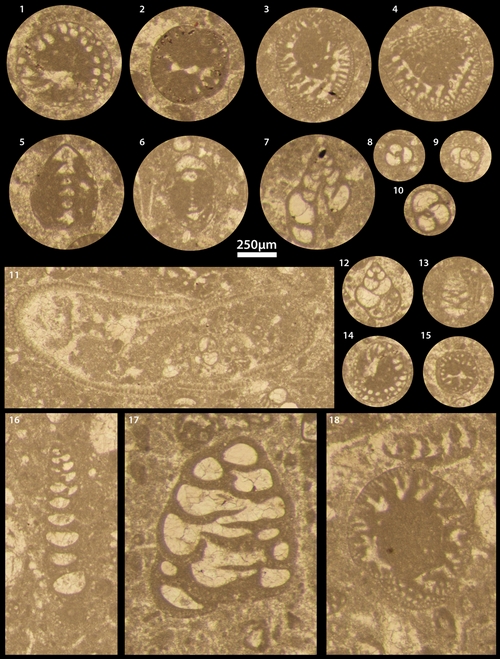
Click on thumbnail to enlarge the image.
Plate 1:
1-18)
thin section from the Collection, labelled "base des Calcaires
inférieurs" (lowermost part of the lower limestones), Callovian-Oxfordian,
East Mrouj (Matn District, Mount Lebanon Governorate, Lebanon). [All photos with
the same graphical scale = 250µm]
1-2
& 14-15) Kurnubia gr. palastiniensis ,
1948b; 3-4
& 18) Kurnubia wellingsi (, 1948b); 5-6) Nautiloculina
cf. circularis ( & , 1959); 7-10 &
12) Siphovalvulina beydouni &
in & ,
2004; 11) Thaumatoporella
parvovesiculifera (, 1922); 13) Coscinoconus sp.; 16)
indeterminate foraminifer (biseriate then uniseriate); 17) Redmondoides
lugeoni (, 1977).
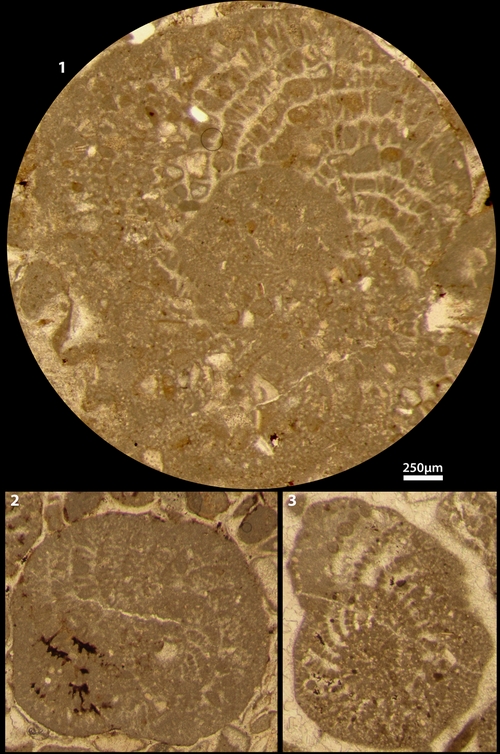
Click on thumbnail to enlarge the image.
Plate 2:
1-3) Choffatella
gr. decipiens , 1904, Jezzinian (uppermost
Barremian). 1-2) El Sfiré (34°24'37.9"N 36°03'22.9"E;
Miniyeh-Danniyeh District, North Governorate, Lebanon); 3) Aintoura Jitta (33°57'18.34"N, 35°37'47.86"E) near Jeita (Matn
District, Mount Lebanon Governorate, Lebanon). [All photos with the same
graphical scale = 250µm]
1) deep
tangential section of a very large specimen, possibly a microspheric form, thin
section SFI2; 2) equatorial section of a macrospheric form, thin section SFI2;
3) deep tangential section of a ? macrospheric form, excerpt of
(2015, Pl. 33, fig. H), thin section Jeita 3.
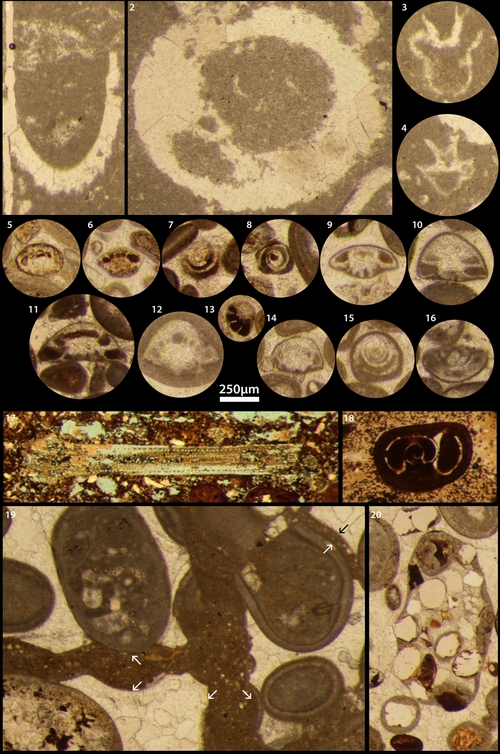
Click on thumbnail to enlarge the image.
Plate 3:
1-20)
thin sections from the Collection, Bikfaya (Matn District, Mount
Lebanon Governorate, Lebanon). [All photos with the same graphical scale =
250µm]
1-4) "Falaise de Bikfaya":
1-2) Campbeliella striata (, 1954), 1)
4 m, 2) 2m;
3-4) Rajkaella bartheli (, 1971), 2m;
5-16) Salima Oolitic Limestones, upper part of the former
"Calcaire de Salima":
5-8) Frentzenella
odukpaniensis (, 1968), 5) 123.8m, 6) 123.3m, 7) 123.3m, 8) 123.3m;
9-10) Coscinoconus sp., 9) 123.3m, 10) 114m;
11-12) Frentzenella
odukpaniensis (, 1968),
11) 123.3m, 12) 108m, 14) 120m, 15) 120m;
13) ? Protopeneroplis
ultragranulata (, 1971), 123.3m;
16) ? Coscinoconus sp., 112.75m;
17-20) "Grès du Liban":
17) mold
of an echinoid radiole, 124.1m;
18)
ferruginous ooid with a nucleus consisting of a gastropod, 125.3m;
19)
sedimentary infilling of fractures (arrowed) by micrite, 125.3m;
20)
extraclasts consisting mostly of quartz grains cemented by calcite, 140m.
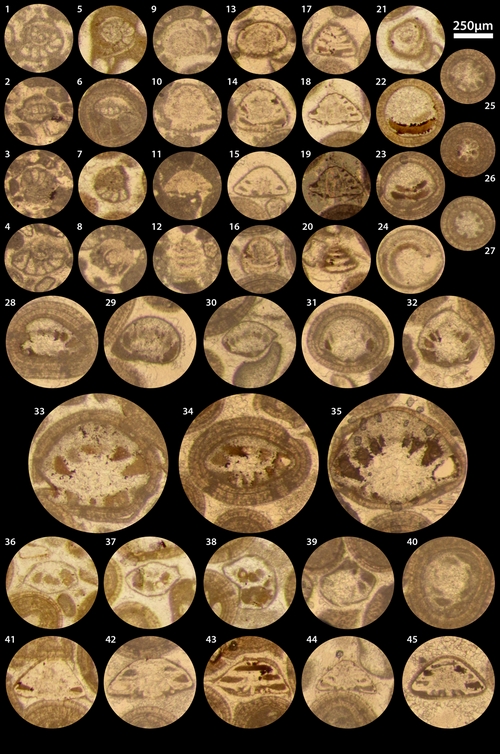
Click on thumbnail to enlarge the image.
Plate 4:
1-4,
8-12) Berriasian (Puig Campana, Alicante, Spain), for comparison; 5-7,
13-45) Salima Fm., Bikfaya (Matn District, Mount Lebanon Governorate, Lebanon).
[All photos with the same graphical scale = 250µm]
1-4) Protopeneroplis
ultragranulata (, 1971), Spain, 1) excerpt of
(1987, Pl. 3, fig. h), 6PC, 2) 9PC, 3) 9PC, 4) excerpt of (1987,
Pl. 3, fig. i), 9PC;
5-7) Protopeneroplis
ultragranulata (, 1971), Lebanon, 5) J7-02, 6) J7-07, 7)
J7-13;
8-12) Neotrocholina
valdensis , 1957, Spain, 8) 6PC, 9) 6PC, 10) 6PC, 11) 6PC, 12)
6PC;
13-21
& 41-45) Neotrocholina valdensis ,
1957, Lebanon, 13)
J7-03, 14) J7-13, 15) J7-11, 16) J7-05, 17) J7-03, 18) J7-20, 19) J7-20, 20)
J7-03, 21) J7-20, 41) J7-02; 42) J7-03; 43) J7-14; 44) J7-08; 45) J7-07;
22-24
& 28-35) Frentzenella odukpaniensis
(, 1968),
22) J7-16, 23) J7-14, 24) J7-02, 28) J7-06, 29) J7-07, 30) J7-09, 31) J7-10, 32)
J7-13, 33) J7-02, 34) J7-11, 35) J7-13,
25-27) Terquemella sp., 25) J7-07; 26) J7-07; 27)
J7-20;
36-40) Epistomina
? sp., 36) J7-19; 37) J7-19; 38) J7-18; 39) J7-05; 40) J7-11.

Click on thumbnail to enlarge the image.
Plate 5:
1-21)
"Grès du Liban" (Barremian), Bkâatouta (Keserwan District, Mount
Lebanon Governorate, Lebanon) [All photos with the same graphical scale = 250µm]
1-4
& 9-10) low-spired Coscinoconus sp., 1) BR1454, 2) ?, BR1454, 3) ?,
BR1454, 4) ?, BR1456, 9) BR1471, 10) ?, BR1470;
5)
medium-spired Coscinoconus sp., BR1455;
6-8) Frentzenella
odukpaniensis (, 1968),
6) BR1457, 7) BR1471, 8) BR1466;
11-12) Freixialina
sp., 11) BR1454, 12) BR1461;
13)
young endolith foraminifers at the base of a Cayeuxia-like structure (for
comparison, see & ,
1980, Pl. 2 figs. 2-3:
"a group of embryonic individuals"), BR1455;
14-20)
high-spired Coscinoconus sp., 14) BR1463, 15) BR1467, 16) BR1463, 17)
BR1461, 18) BR1471, 20) BR1463;
19)
ferruginous ooid and Coscinoconus sp., BR1461;
21) Balkhania
balkhanica , 1966. Specimen with a
complex embryonic apparatus consisting of a small
protoconch (above) and a larger deuteroconch (below), BR1463.
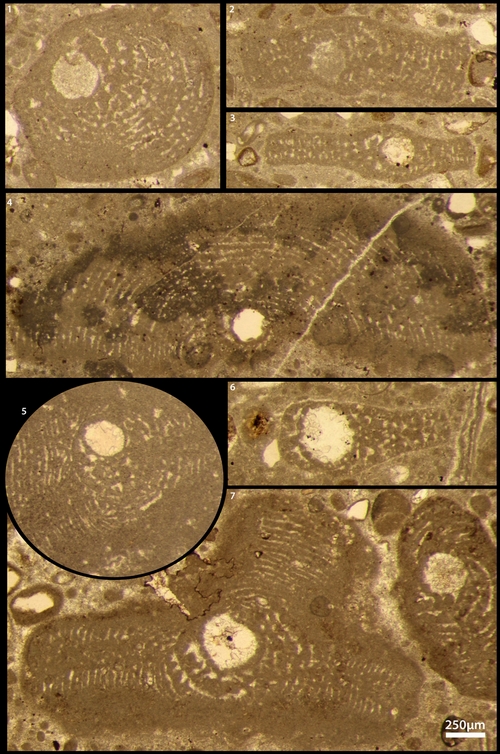
Click on thumbnail to enlarge the image.
Plate 6:
1-7) Balkhania
balkhanica , 1966, "Grès du Liban" (Barremian), Bkâatouta
(Keserwan District, Mount Lebanon Governorate, Lebanon). [All photos with
the same graphical scale = 250µm]
1) Specimen with a complex embryonic apparatus consisting of a small
protoconch (above) and a larger deuteroconch (below), BR1453;
2) BR1453; 3) BR1453; 4) BR1461; 5) BR1472; 6) BR1465; 7) BR1466.